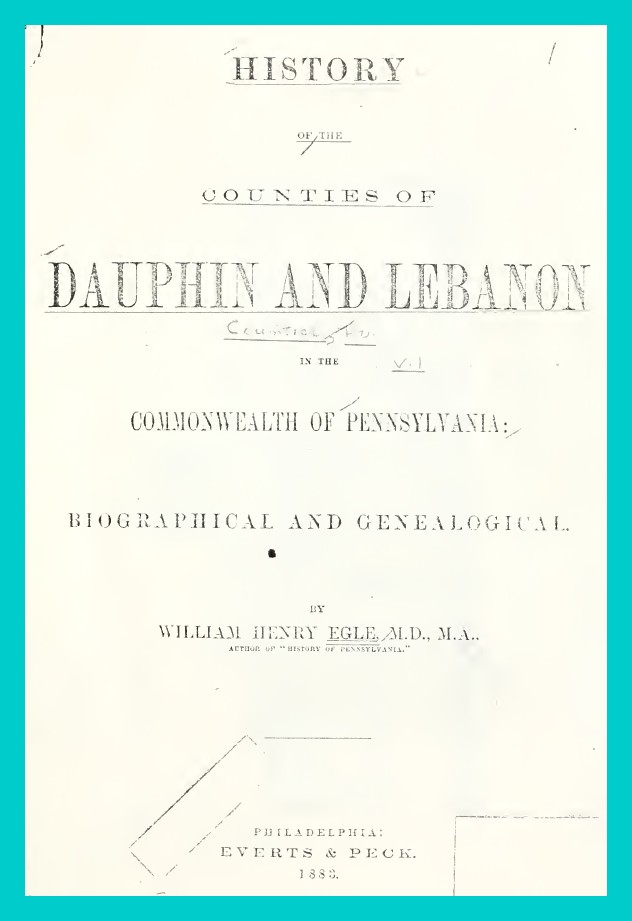On the question of when Gratz was actually founded, William Henry Egle noted in 1883 in a selection entitled “Gratz Borough,” noted, without providing proof, that the town was “laid out in 1805 by Simon Gratz.
Some interesting information provided by Egle:
(1) In looking at the question as when the first houses were built, Ludwig Schoffstall is mentioned as the one who built the earliest house, but Egle fails to give a date when Schoffstall built the house, only that it was one of five houses there before 1819.
(2) The fifth house was supposedly occupied by a “George Crapp,” whose name does not appear as an early resident in later sources. Egle indicates he was a tenant of a Mr. Wise. This could possibly be “Peter Crabb,” the African American who was one of the early settlers, but whose name disappears in later writings. The date that Peter Crabb actually arrived in Gratz has not been conclusively determined, but it is known for certain from other writings that he was there well before 1830.
(3) Egle concludes with a brief history of three churches serving the town, only one of which was located within the borough, the other two being in the township.
The following is from History of the Counties of Dauphin and Lebanon, Commonwealth of Pennsylvania, Biographical and Genealogical, by William Henry Egle. Published by Everts and Peck of Philadelphia, 1883. Pages 452-453.
Note: This book is available on the web as a free download from the Internet Archive.
___________________________________
GRATZ BOROUGH
Gratz was laid out in 1805 by Simon Gratz. It is situated on the road leading from Millersburg to Reading, thirty miles from Harrisburg. It was incorporated into a borough April 3, 1852. In 1838, Mrs. Frey kept the tavern and Solomon Shindle a store. The oldest resident of the place is Squire George Hoffman, who was born two miles east of the borough, March 13, 1798. He was the son of John Nicholas Hoffman and Margaret [Harman] Hoffman, one of the earliest settlers in the valley and a prominent family. Squire Hoffman has been magistrate for the past forty-five years. When he came to Gratz in 1819, there were only five houses in the place; one was the oldest house, built here by Ludwig Schoffstall, now owned by Edward L. Umholtz. The second was built by Lewis Faust, who sold it to Rev. William Hedel, now belonging to the estate of A. K. Kepler, deceased. The third was occupied by George Feagley, and fourth by Adonijah Matthias, a Frenchman. The fifth was occupied by George Crapp, a tenant of Mr. Wise. The store was kept by Conrad Frey, then by his widow, and later by her son-in-law Solomon Shindle.
The municipal officers of the borough since its incorporation have been:
BURGESSES
1852 – Theodore Gratz
1853 – Daniel Good
1855 – Jonas Laudenslager
1856 – Daniel K. Osman
1857 – Daniel Lehr
1859 – George Hoffman
1860 – Daniel Good
1861 – Dr. I. S. Schminky
1864-1868 – No Record
1868 – Daniel Good
1869-1870 – No Record
1876 – Frank Fidler
TOWN CLERKS
1852 – James Kissinger
1853 – Abram Hess
1856-1876 – No Record
1876 – J. A. Willier
1878 – H. W. Good
This town, located on the old Reading Road, was the centre and field of the old-time militia musters, at which thousands used to assemble to witness the evolutions of the battalions. Jacob Hoover had a noted grist-mill two miles distant on the Little Wiconisco. After the opening of the coal mines a post office was established. The present postmaster [1883] is J. Arnholtz, and he predecessors (as far as ascertainable) were Jacob Buffington, Solomon Shindle, and C. T. Bowman. The ridge on which the borough stands was in old times called “Wild-Cat Ridge,” from its being the abode in pioneer times of wildcats.
Then followed the mention of three early churches, one of which was in Gratz, and two of which were in Lykens Township:
ST. SIMEON’S EVANGELICAL LUTHERAN AND REFORMED CONGREGATIONS were organized in 1823, and until 1832 preaching was had in a house built by Mr. Gatz [sic] where William Boyer now [1883] lives. A joint church edifice was built in 1832. Rev. Isaac Gerhart was the first Reformed and Rev. John Peter Shindel the first Lutheran pastor, and the Rev. Joseph Hilpot the present Lutheran incumbent. The pastors of St. John’s Lutheran and Hoffman Reformed Churches have generally preached here.
HOFFMAN REFORMED CHURCH – This old church edifice, a two-story frame, built over half a century, is two and one-fourth miles from Berrysburg, three from Gratz, and is in Lykens Township. The ground on which it was erected was donated by Squire John Hoffman, who was a magistrate from his twenty-fifty year until his death in 1877.
COLEMAN CHURCH – This Union Church of the Lutheran and Reformed Churches near the Schuylkill County line, in the extreme eastern part of Lykens Township. St. Matthew’s is the the name of the Lutheran congregation, which is supplied with preaching by pastors of St. John’s Church, Rev. Joseph Hilpot being the present incumbent.
______________________________________
Corrections and additional information should be added as comments to this post.
[African American]
